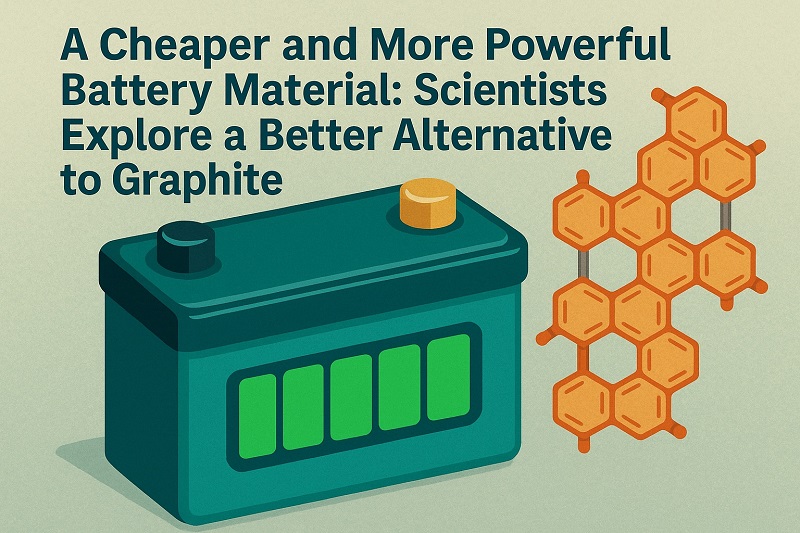Metal-ion batteries use graphite as their main anode material today. There are several drawbacks to it, such as its small capacity, which restricts...
Vous n'êtes pas connecté
Rubriques :
 - WN.COM - Science - Hier 00:49
- WN.COM - Science - Hier 00:49
Skoltech Discovers High-Capacity Battery Anode Material, Offering Graphite Alternative
Metal-ion batteries use graphite as their main anode material today. There are several drawbacks to it, such as its small capacity, which restricts the operating time of phones, computers, and other equipment, and its high cost. ......
Articles similaires
High-capacity battery anode material offers graphite alternative
Skoltech researchers have investigated the use of polyaromatic hydrocarbons as anode materials in metal-ion batteries. The high capacity, low...
Scientists find a way to boost battery life without rare materials
Batteries power many things in our daily lives—from smartphones to electric vehicles—but the material used inside them is far from perfect. Right...
Scientists find a way to boost battery life without rare materials
Batteries power many things in our daily lives—from smartphones to electric vehicles—but the material used inside them is far from perfect. Right...
A deeper look at hidden damage: Nano-CT imaging maps internal battery degradation
The minerals that power lithium-ion batteries—including lithium, nickel, cobalt, manganese, and graphite—are both highly valuable and difficult to...
A deeper look at hidden damage: Nano-CT imaging maps internal battery degradation
The minerals that power lithium-ion batteries—including lithium, nickel, cobalt, manganese, and graphite—are both highly valuable and difficult to...
New imaging method reveals how lithium-metal batteries lose capacity over time
Lithium-metal batteries have not hit the market yet, but if they do, they could be a solution to the everyday woes of the dwindling battery meter....
New imaging method reveals how lithium-metal batteries lose capacity over time
Lithium-metal batteries have not hit the market yet, but if they do, they could be a solution to the everyday woes of the dwindling battery meter....
MoS₂ thin films extend lifespan of anode-free solid-state batteries by seven-fold
South Korean researchers have developed a technology that improves the lifespan of next-generation anode-free all-solid-state batteries (AFASSBs) by...
MoS₂ thin films extend lifespan of anode-free solid-state batteries by seven-fold
South Korean researchers have developed a technology that improves the lifespan of next-generation anode-free all-solid-state batteries (AFASSBs) by...
Les derniers communiqués
-
Dr. Tony Bennett Returns to Strategos Group as Partner Emeritus
Strategos Group - 25/06/2025
-
Nike Brings Innovation to Every Run
NIKE INTERNATIONAL LTD - 24/06/2025
-
The Nike Vomero Plus Goes Big on Cushioning. The Vomero Premium Goes Even Bigger.
NIKE INTERNATIONAL LTD - 24/06/2025
-
ST Engineering iDirect and solutions by stc Strengthen Strategic Partnership to Advance Satcom Services in Saudi Arabia
ST Engineering iDirect - 19/06/2025
-
JT Global to join Aduna to advance secure CPaaS solutions with Network APIs
JT Global - 19/06/2025
-
Resecurity Partners with CSL to Fortify Cybersecurity Landscape in Colombia
Resecurity - 18/06/2025
-
Clarivate Unveils the 2025 Journal Citation Reports
Clarivate Plc - 18/06/2025
-
Syniverse to team up with Aduna to expand access to network APIs
Syniverse - 18/06/2025
-
Tellus Power Globe Holding Limited, BinHendi Holding and Sing Family Enterprise Group Sign Joint Venture Agreement to Launch One of the First EV Charger Manufacturing Companies in Middle East with Support of UAE Ministry of Investment
Tellus Power Globe Holding Limite - 18/06/2025
-
Mine Vision Systems Expands Global Support Network with New Australian Partnership
Mine Vision Systems - 17/06/2025
